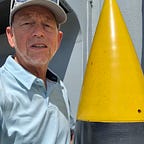The largest battleship salvo in the world: Operation Katie (kt)
In the 1950’s the US Navy developed the MK23 nuclear shell for deployment aboard Iowa class battleships
Background
We are all familar with the role of battleships as seen in videos from WWII. Scenes of battlewagons standing off shore lobbing 16" shells onto an enemy held island supporting amphibious landings are everywhere on the History channel and youtube.
Battleships by design are stand off weapons, due to their large gun caliber. The Mark 7 16"/50 caliber series of battleship guns were designed in the 1930’s to comply with the Washington Naval treaty requirements. The number 50 denotes they are 50 times as long (66.7 feet)as their bore size (16"). They are able to propel a 2,700 lb. shell up to 24 miles. The shell would take up to 90 seconds to complete the flight before impact.
An Iowa class battleship is equipped with nine 16" guns arranged three to a turret, with two turrets at the bow and one at the stern. What you see above the deck of the ship is actually just the gun barrels protruding above the gun deck of the turret. The actual turret itself extends down four to five decks deep into the ship.
The MK 7 16" 50 caliber gun weighs in at over 239,000 lbs and each barrel can be raised or lowered independently of the others. It takes 79 men to man all the four levels of the turret from the powder handling level to the gun deck. The 16" guns of the Iowa class battleship can fire up to two rounds per minute.
During the invasion of Okinawa in April of 1945, the US Navy assembled the largest collection of battleships ever gathered. There were 18 in total, along with 25 cruisers to provide shore bombardment of the island. A collection of so many large caliber naval guns would never be seen again.
The Shells
An Iowa class battleship would typically carry a load of approximately 1200 rounds for their 16" guns. These would be a mix of practice rounds (9–10) per barrel, and 130 live AP or HC rounds per barrel.
A single high capacity (HC) MK13 shell (1,900 lbs) fired from a 16" naval cannon could deliver a devastating blow to a land target, making a crater 50 feet across and 20 feet deep and defoliating trees within 500 yards of the point of impact. Interestingly in Vietnam the battleship USS New Jersey fired HC rounds to create instant helicopter landing zones.
The MK8 “super heavy” heavy armor piercing (AP) shell (2,700 lbs)was capable of penetrating up to 30 feet of concrete or over 13" of armor plate or 6.5" of deck armor. It made the 16" guns of the Iowa class battleships roughly equivalent to the 18" guns of the Japanese super battleship Yamato.
These shells were propelled by the ignition of six 110 lbs bags of propellent that would be hand loaded into the loader by two men.
Operation Katie…the surface Navy acquires some kt (kilotons)
In the early 1950’s as the Korean War was raging, the US Navy was tasked with adapting the Army’s Mark 8 11" tactical nuclear artillery shell for use with 16" battleship fleet guns.
In effect, the surface Navy was getting in the nuclear game that until that time was only the scope of the Army, Air Force and submarine force. The Navy was getting some kilotons. If you say it fast three times kt, kt, kt, you’ve got the beginning of Operation Katie (kt).
The Mark 8 shell was fitted into an exisiting MK13 shell casing with appropriate changes to the blasting charges and detonating charges. It was designed with a 15–20 kiloton nuclear warhead, the same kiloton range as the Hiroshima and Nagasaki bombs dropped to end WWII.
Three of the of the Iowa class battleships (New Jersey, Wisconsin and Iowa) were modified to recieve these new shells when they became available in 1956. A separate storage area within the number two turret magazine was created with 24/7 security. The warhead was stored in a separate secured locker away from the shell. It was the assemblers job to mount the warhead on the shell and get it ready for firing.
There were 50 of these weapons produced. Each Iowa class battleship was allocated ten MK23 nuclear shells (1 per barrel + 1 back up) and nine practice rounds.
That meant that one battleship was capable of firing nine of the Mark 23 shells making a salvo total yield of 135–180kt.
On paper it is the most powerful gun salvo in the world!
Since just 15–20 kilotons could devastate an entire city with an airburst, it is interesting to consider what the philosphy of employing this weapon by the fleet might be. There is some conjecture that while the Navy had planes capable of delivering nuclear warheads, the use of naval guns would ensure accuracy and all weather capability. It was also thought the weapon could be used to a devastating effect against an enemy fleet disabling or destroying an entire task force in one blow!
It is not clear from naval records if any shells were ever loaded aboard the Navy ships (still classified). It was recorded that the USS Wisconsin fired one of the practice rounds in 1957 so there is some reason to believe the ship carried the real thing as well.
While the era of the battleship lasted over 100 years, thankfully the use of the MK23 shells was never undertaken.
